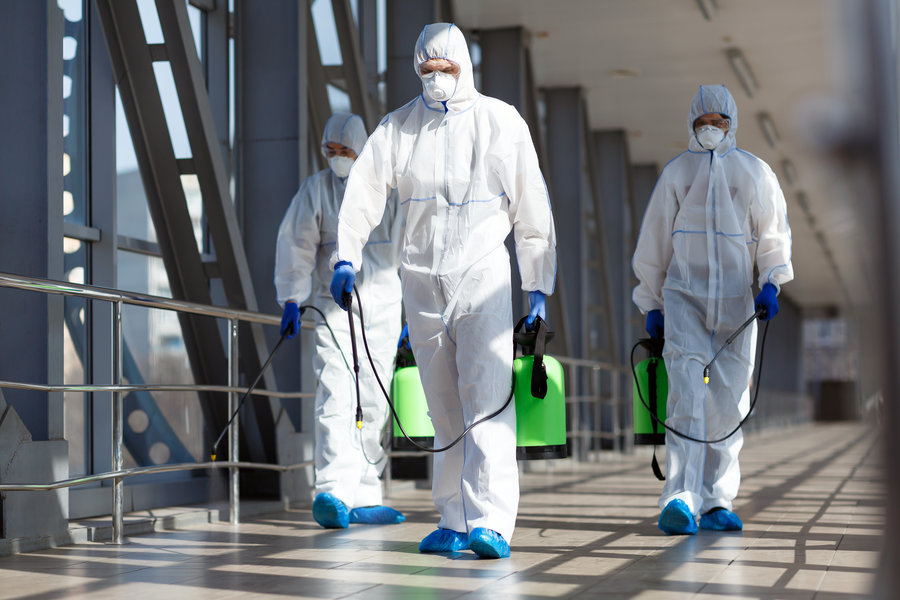
Request A Call Back
Covid Cleaning – Introduction
When it comes to cleaning, businesses must implement specific procedures to effectively manage the supply, use, cleaning and disinfection, laundering, and disposal of all clothing, PPE, and equipment.
We strongly advise that all employers familiarise themselves with the provided information. A link to the comprehensive Guidance Notes on Cleaning from the UK Government is available here.
To help our clients stay compliant and safeguard their staff and customers, we offer essential deep cleaning and disinfection services for entire buildings. This ensures that premises are not only visibly clean but also free from harmful bacteria and viruses.
Alternatively, if you have an in-house cleaning team, they can clean your buildings, while we can deliver a touchless disinfection service. This provides added assurance that your sites are not only visibly clean but also thoroughly sanitised, eliminating harmful bacteria and viruses, including COVID-19.
In this new era where cleaning has become a prominent and visible concern for building users, it is crucial to understand the terminology within the cleaning industry. Later, we will explore the range of cleaning and disinfection services offered by SHS Hygiene, tailored to your specific needs.
First, let’s take a closer look at what you can do to limit the spread of COVID-19 or manage an outbreak on your premises, along with the appropriate cleaning and disinfecting processes.
What cleaning should I do to prevent or limit the spread of Covid-19 and after a confirmed case of Covid-19?
If you have received confirmation that a staff member or customer who has been on your premises has been diagnosed with the Covid-19 virus, it is essential to carry out a deep clean followed by a disinfection service. Special attention should be given to the following areas:
External
- Outdoor Furniture such as dining tables
- Entrance Gates & Barriers
- Door Security Pads
- Entrance Door Handles
- Drive Through furniture
- Waste & recycling bins
- Company vehicles
Internal
- Internal door handles
- Baskets & trollies (retail outlets)
- Food preparation and dining areas
- Toilets
- Fridges, kettles, taps
- Vending machines
- Stair handles/bannisters
- Recycling areas
Sanitising or Disinfecting without Cleaning will not control or prevent the spread of Covid-19
It is crucial that everyone involved in the maintenance of your building is aware of and understands the distinctions between Cleaning, Sanitising, and Disinfecting.
Many companies are mistakenly implementing Sanitising and Disinfection procedures without carrying out the necessary cleaning beforehand, which will neither control nor prevent the spread of the Covid-19 virus.
To provide some clarity, we classify these as follows:
cleaning
the process or activity of removing dirt and grime from items, surfaces and places
sanitising
a step further than cleaning but more gentle than disinfection, reducing the presence of bacteria to safer levels, thereby reducing the risk of infection, it may not kill viruses (3-log kill)
disinfecting
kills everything with the right product and concentration, destroying and eliminating bacteria, pathogens and micro-organisms that cause disease (6-log kill)
At SHS Hygiene we provide deep cleaning and disinfection services and as such decontaminate rooms, areas and objects to 6-log kill. We offer the following service solutions for pathogens, viruses including Covid-19.
Deep Cleaning & Enhanced Disinfection Services chosen and offered by SHS Hygiene:
STEP 1. DEEP CLEANING
WHAT
Disinfectant cleaning
WET/DRY
Wet
WHY
A deep disinfectant clean should take place prior to any of the other services or you risk sanitising the dirty and not the fabric of the building
WHERE
Everywhere including kitchens and catering equipment
HOW
Using deep cleaning methods followed by a disinfectant cleaning service
DWELL TIME
Immediately
STEP 2. FOGGING
Perfect Outdoors
WHAT IS IT
Backpack ULV Fogging
Perfect Rooms
WHAT IS IT
Whole room/wards fogging
Perfect Indoors
WHAT IS IT
Electrostatic Disinfection Case fogging
WET OR DRY
Wet
WET OR DRY
Dry
WET OR DRY
Dry
WHY
Heavier droplets/microns that won’t get blown away. A wet fog that is suitable to outdoor areas and large environments
WHY
To disinfect wards, hospital rooms, hotel rooms and offices
WHY
Much less “drift”, better surface coverage (under, over, in-between), improved surface dwell time, and safe for use on electrical and IT equiment / smoke alarms. Offers a 360 degree “wrap” to surfaces by charging the silver element in the chemical.
WHERE
Bus shelters, pavilions, changing/shower rooms, train stations
WHERE
Offices, hotel rooms, wards. Indoors only and often used in conjunction with electrostatic fogging to reduce time on site. Can be set up and left to fog unmanned
WHERE
Ductwork, clean rooms, offices, workspace environments
HOW
Backpack ULV fogger generally a low cost fogging method involving low cost equipment
HOW
Plug in, set up and leave
HOW
Electrostatic “suitcase” style fogger This is a purpose built machine and not a “fogger” you can pick up on the open market. Electrostatic foggers are the highest level of fogging for the office environment with almost 100% cover and short dwell time
STANDARD
Silver
STANDARD
Gold
STANDARD
Platinum
DWELL TIME
Around 2 hours
DWELL TIME
From 2 hours
DWELL TIME
After 30 minutes
Perfect Deep Clean
A traditional deep cleaning service involves the manual application of a logkill 6 disinfectant product, which is effective against the 2019 Wuhan Novel Coronavirus. Once the service is completed, the premises, including food preparation surfaces, will be ready for use as soon as the team has vacated the site.
Perfect Indoors, Perfect Outdoors & Perfect Rooms
Fogging Services – Touchless Disinfection
Manual deep cleaning involves wiping surfaces, but on its own, it is not entirely effective in eliminating harmful bacteria and viruses. It may miss or inadequately clean areas that are difficult for cleaners to reach, such as beneath tables and in the gaps between cupboards. This can result in the creation of hotspots, where a high concentration of bacteria can thrive.
Fogging or misting, using hydrogen peroxide atomising or electrostatic machinery, offers a more comprehensive solution. This process combines the capabilities of both spraying devices (fogging) and disinfectant solutions, allowing for automatic disinfection of the air, surfaces, and entire rooms. It represents the highest level of disinfection, decontamination, and outbreak control available on the market.
Our fogging procedures focus on critical high-contact areas, including door handles, desks, handrails, washrooms, and other key touch zones. We provide an enhanced disinfection service using hydrogen peroxide with silver (Halosil disinfectant).
All of our disinfectant products are specifically designed to decontaminate all hard surfaces and comply with EN standard 14476, ensuring effectiveness against a range of viruses. These products do more than simply render micro-organisms inert; they have been shown to kill them by disrupting the RNA of the micro-organisms, thereby preventing the development of resistance.
Our disinfectants kill COVID-19 (log kill 6)
100% biodegradable and environmentally friendly
Approved hospital-grade disinfectant, for use in operating theatres wth delicate theatre systems
Civil Aviation Authority approved
Halal and Kosher certified
Safe to use in food preparation areas
We utilise high-grade machinery to apply disinfectants, tailored to meet the specific needs of our clients in terms of time, cost, and objectives. Depending on these bespoke requirements, we deploy ULV fogging backpacks (Perfect Outdoors), electrostatically charged disinfection cases (Perfect Indoors), or dry fogging machines (Perfect Rooms).
These machines effectively distribute disinfectants across your site, whether indoors or outdoors, and are proven to eradicate bacteria and harmful viruses, including COVID-19, in the air and on all surfaces, walls, and flooring.
Perfect Outdoors
Electro-Hygiene Atomisers
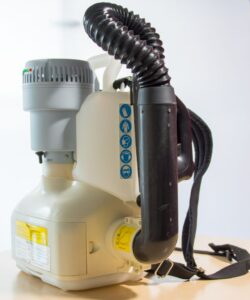
PSS Electrostatic Disinfection Cases
Our advanced disinfection process ensures uniform coverage of all surfaces, including electronic equipment, without causing corrosion or oxidation, making it ideal for touchscreens in your facilities.
The dry spray technology we use leaves no wet residue behind, ensuring a clean and safe environment without any moisture-related concerns.

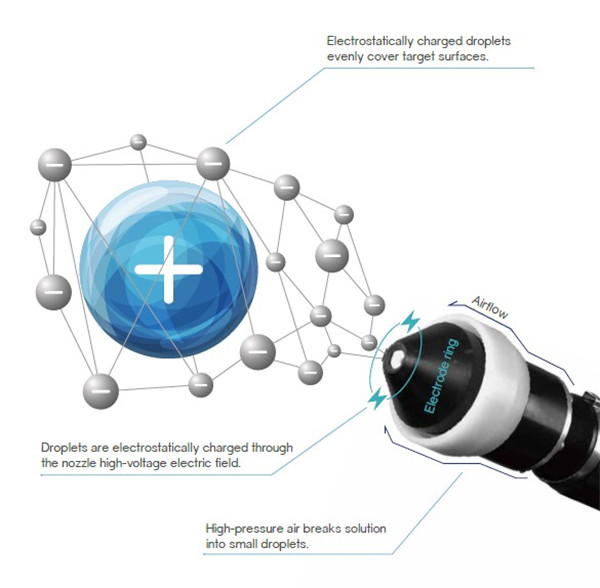
Dry Fogging Machine
The HaloFogger offers a uniform dry fogging service that ensures comprehensive surface disinfection throughout entire rooms. It automatically delivers a precise amount of disinfectant solution, effectively eliminating pathogens in a variety of environments, including healthcare, hospitality, clean rooms, childcare settings, gyms, and more.
After the service, the premises, including food preparation surfaces, will be ready for use within 2 hours. The disinfectant’s effectiveness has been rigorously tested and confirmed against numerous pathogens, including Coronavirus.
Additionally, the process provides some residual disinfecting benefits, thanks to the inclusion of silver in the solution.
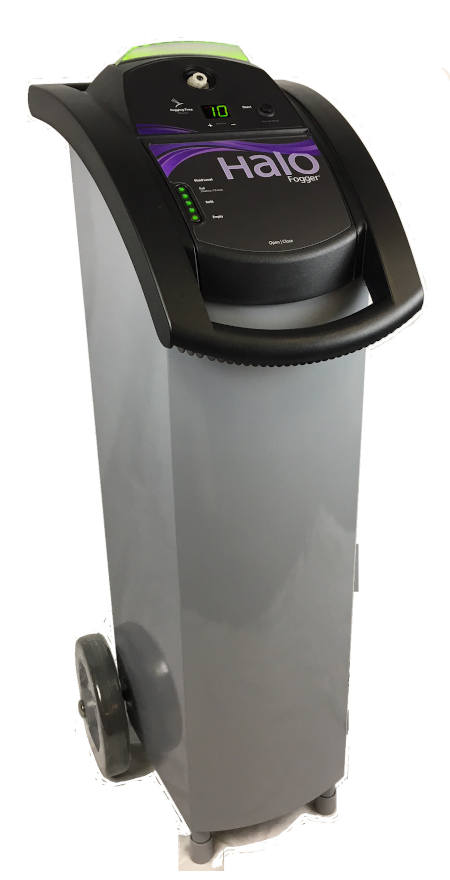
How does Halosil fogging kill germs?
This method involves releasing a cloud of hydrogen peroxide into an area, which then settles on all surfaces. The hydrogen peroxide disinfectant, enhanced with silver, is DEFRA approved.
When the machine disperses the dry mist of hydrogen peroxide, it immediately targets the outer structure of any micro-organisms present in the room. This weakens the organism’s structure, allowing the silver to penetrate and initiate the disinfection process. Once inside the cell, the hydrogen peroxide and silver compromise its integrity, disrupting the cell’s functions.
The process halts regeneration by binding to the organism’s DNA, and it further disrupts the cell’s energy source by attaching to the cell’s enzymes, leading to a rapid demise of the micro-organism.
After completing its job, the hydrogen peroxide breaks down into harmless water and oxygen, leaving no residual harmful chemicals behind.
We allow 1 hour for the solution to settle, known as ‘dwell time,’ and then ventilate the area until the hydrogen peroxide concentration falls below 1ppm, ensuring a safe environment for re-entry.
In summary, the area needs to remain vacant for a total of only 2 hours.
How does Halosil work?
The secret of the Halosil disinfectant is the combined 2-phase effect of the main ingredients hydrogen peroxide (H2O2) and silver.
The oxygen split off by the hydrogen peroxide attacks the cell walls of the microorganisms upon direct contact.
The chemical reaction of the oxygen with molecules in the cell walls denaturises and destroys these.
This effect is boosted by silver ions that bind to the disulfide bonds of certain proteins, both of the reproduction complex as well as of the metabolic system of the microorganisms, and deactivate or precipitate these.
To put it simply: the hydrogen peroxide affects the membrane of the microorganisms, the silver the inside.
This combined “hammer and ambos” effect boosts and/or exponentiates the biocide effect of hydrogen peroxide and silver on a large scale.
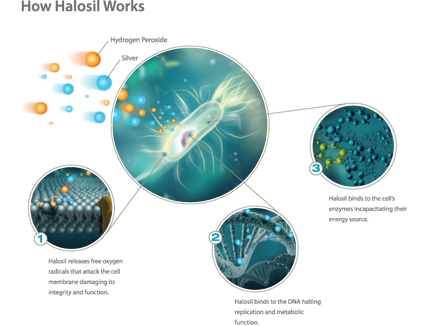
Proven to eradicate over 280 pathogens, including:
Superbugs – Coronavirus, MRSA/Staph, C.diff (incl. spores), Klebsiella, VRE
Bacteria – Legionella, TB, Salmonella, E.Coli, Listeria, Campylobacter
Viruses – COVID19 Norovirus, Influenza (incl. Bird & Swine), Polio, Rhinovirus, Hepatitis C & B HBV, HIV Fungi (Moulds & Yeasts) – Black Mould, Candida, Botrytis.
While H2O2 breaks down into water and oxygen (H2O2= H2O+O2) afterwards, minute traces of silver remain on the disinfected surface. These traces are invisible but actively and effectively counteract re-germination.
What makes Halosil different to other Hydrogen Peroxide solutions?
Halosil is a patented, ready-to-use formula that blends hydrogen peroxide and silver. Hydrogen peroxide is the oxidising agent and the silver adds a broad-spectrum anti-microbial element to this unique formula.
A complex blending process stabilises the H202 while amplifying the anti-microbial action ten-fold delivering a formula that behaves completely different to its original ingredients.
The result is a radical fluid architecture, a multi-faceted killing mechanism against pathogens. Halosil is so effective, all premises will receive a certification following treatment guaranteeing the site is sanitised and clear of COVID-19 or other harmful bacteria, which can be displayed for the reassurance of staff and customers.
How does Halosil compare to other disinfectants?
Superior Efficacy: Halosil is a broad-spectrum disinfectant that kills a wide range of bacteria, viruses and fungi. It performs equal to, if not better than, other disinfectants.
Does Halosil provide residual disinfecting?
Yes. The chemical used leaves behind a safe, undetectable layer of silver ions on surfaces. This can help prevent future contamination of the surface. Silver helps to stabilise hydrogen peroxide which enhances the residual disinfecting effect. Silver with hydrogen peroxide shows a two log increase in kill activity and it in itself can kill several bacterial species. Silver particles remain stable in air and water.
However, overtime, once surfaces have been wiped or disinfected, silver particles will be lost due to conditions such as temperature, time and concentration.
Guide to Decontamination by Fogging
In order to demystify the fogging industry we’ve prepared the following on decontamination using vapours and gas aka ‘fogging’ and assumes that you have already performed a deep clean on the area, object, room or premises in order for it to be effective.
1. Ozone Fogging
Ozone – The Science
Ozone is a naturally occurring gas formed from oxygen atoms. While an oxygen molecule consists of two oxygen atoms, single oxygen atoms are unstable and quickly recombine to form diatomic oxygen molecules. During this recombination process, some atoms form a loosely bonded tri-atomic oxygen molecule, known as Ozone or O3.
Ozone generators create ozone from normal air and are commonly used for room disinfection. Much of the research on ozone’s virucidal effects has focused on its ability to disrupt lipid molecules at sites of multiple bond configurations.
When ozone breaks apart the lipid envelope of a virus, the virus’s DNA or RNA core is unable to survive. Enveloped viruses, such as COVID-19, are typically more susceptible to physico-chemical challenges than non-enveloped viruses. Although ozone’s interaction with unsaturated lipids is well-documented, it also affects proteins, carbohydrates, and nucleic acids.
The new coronavirus, COVID-19, is an enveloped virus, making it particularly vulnerable to the effects of ozone.
Ozone – Laymans Terms
Ever wondered why the air smells so clean and fresh after a lightning storm? This distinctive scent is due to the lightning passing through the oxygen in the air, resulting in the creation of ozone.
Oxygen, which makes up nearly 21% of the air we breathe, is a gas composed of two atoms. The remaining air consists primarily of nitrogen, with smaller amounts of carbon dioxide and water vapour.
Ozone, on the other hand, is formed when oxygen is exposed to a strong electric field, causing it to acquire a third oxygen atom. When this tri-atomic oxygen, or ozone, encounters a contaminant molecule, one of the oxygen atoms quickly detaches from the others and bonds with the contaminant in an attempt to reach a more stable state.
However, instead of achieving stability, this reaction triggers a mini explosion that effectively destroys both the contaminant and the extra oxygen atom, converting them into carbon dioxide and hydrogen.
This microscopic process eliminates the contaminant along with any associated odour or microbiological presence, leaving behind only a stable oxygen molecule once the ozone has dissipated.
This process, known as oxidation, results in atmospheric oxygen as the only by-product.
Ozone – The Positives
- Effectiveness – Ozone has been proven to effectively combat bacteria, viruses, fungi, spores, and biofilms.
- Fully Automated Disinfection – The system operates without the need for an operator to be present during treatment, leading to long-term cost savings by eliminating the need for staff to physically sanitise rooms and equipment each night.
- Complete Coverage – As a gas, ozone is able to penetrate hard-to-reach areas that might be overlooked during regular cleaning cycles, ensuring thorough disinfection.
- No Residue – Ozone naturally degrades back into oxygen, leaving no residue behind.
- Health & Safety – Ozone technology has significantly advanced over the past decade, making it safer to use, although there is still some associated risk.
- Widely Proven in the Field – Ozone is extensively used by European and American food factories to disinfect storage rooms and production facilities. Major UK food manufacturers are also adopting this technology to combat persistent pathogens such as Listeria, E.Coli, Salmonella, and Campylobacter.
- Extends Shelf Life of Food Products – In addition to being a surface disinfectant, ozone can extend the shelf life of produce by inhibiting the production of ethylene, which is released by fruits and vegetables, thus keeping them fresh for longer.
- Odour Elimination – Ozone effectively removes all odours.
Ozone – The Negatives
- Slow Delivery Method – The process of using ozone for disinfection is relatively slow.
- Health Risks – Even small amounts of ozone can be harmful when inhaled. Symptoms may include coughing, shortness of breath, and the worsening of lung conditions such as asthma. Although ozone can be detected by smell at higher concentrations, it is harmful even at lower levels. For this reason, many countries have set an 8-hour exposure limit of 70 ppb (parts per billion) ozone, with the EU setting an even lower limit.
- Not a Quick Process – Due to the potential health risks and the slow nature of ozone disinfection, this is not a fast service, and improper management can lead to significant consequences.
- Variety of Machinery – The wide range of ozone-generating machines, with different sizes and ozone levels, can make it challenging to choose the right equipment to effectively disinfect a specific area.
2. UV Fogging (Ultra Violet Light)
UV – The Science
UV disinfection machines are increasingly being adopted in hospitals worldwide. Traditionally, these machines have been used to disinfect rooms after they have been occupied by patients with particularly high-risk infections.
UV light works in various ways, depending on the target. It effectively kills microorganisms by damaging their Deoxyribonucleic acid (DNA).
On a molecular level, UV light disrupts the existing bonds in DNA and prompts the formation of new ones.
Since DNA is the fundamental ‘code’ that allows living organisms to function and reproduce, the damage caused by UV light makes this code difficult to ‘read.’ Once sufficiently damaged, the microorganism can no longer survive or reproduce.
Although coronaviruses do not contain DNA—they have a similar type of genetic material called Ribonucleic acid (RNA)—research has shown that UV light can also be effective against coronaviruses.
UV – Laymans Terms
UV light primarily originates from the sun, but there are also artificial sources, such as tanning beds and UV disinfection lamps.
There are three classes of UV light: UV-A, UV-B, and UV-C.
UV-A and UV-B light are known to cause sunburns and premature skin aging, and exposure to these types is linked to the development of skin cancer.
UV-C light, which has the highest energy of the three, is the most harmful. However, it does not reach the Earth’s surface because it is absorbed by the ozone layer.
Nonetheless, UV-C light can be synthetically produced. This manufactured UV-C light is used in UV-C sanitizers that are claimed to kill the coronavirus.
According to the National Academy of Sciences, it is likely that UV-C does kill the COVID-19 coronavirus. This belief is based on the fact that UV light has long been used to disinfect surfaces and water, and over 100 years ago, it was employed to kill flu viruses in hospitals.
UV-C light is effective because it is powerful enough to destroy the genetic material—whether DNA or RNA—of viruses and bacteria.
UV – The Positives
- Chemical-Free – UV disinfection is a chemical-free process, ensuring no harmful residues are left behind.
- Effective – It can achieve a Log Kill of 6, though it generally achieves a Log Kill of 4.
- Immediate Access – The room can be re-entered immediately after the UV light is switched off.
- User-Friendly – In principle, it’s as simple as plugging in the device and letting it operate.
UV – The Negatives
- Variety of Bulbs – There are many different types of bulbs, varying in power, type of light, and UVC output, which can be confusing. Some may be untested due to the rush to market during the Covid-19 pandemic.
- Wide Range of Options – With a vast array of products available, it can be difficult to determine which one is best suited to your needs.
- Training Requirements – Significant training is necessary to operate UV disinfection systems effectively.
- Coverage Limitations – Shadows can reduce the effectiveness of UV coverage, meaning it may take a considerable amount of time to fully “light” a room.
- Health Risks – Even brief exposure to UV-C light can be extremely harmful to humans, so the area must be completely vacated before use. This is particularly important in open-plan offices or rooms with windows facing another office.
- Pre-Cleaning Necessary – Areas must be thoroughly cleaned before UV disinfection, as microscopic shadows can leave sections unsanitised.
3. ULV Fogging (Ultra Low Volume) (Perfect Outdoors)
The Science
ULV (Ultra-Low Volume) fogging machines are typically cold fogging devices that use large volumes of air at low pressures to convert liquids into fine droplets, which are then dispersed into the air. These machines can produce exceptionally small droplets, ranging from 1 to 150 μm in diameter. ULV machines are commonly used for applying various chemicals, including pesticides, herbicides, fungicides, sterilizers, and disinfectants.
The size of the droplets is crucial, as each application has an optimal droplet size. For effectively tackling Covid-19, the ideal droplet size ranges between 5 and 20 μm.
The term “low volume” refers to the minimal amount of carrier fluid required by these machines. Due to the small size of the droplets produced, less carrier fluid is needed to cover the intended surface area.
To better understand this concept, consider the mathematical relationship between droplet size and the number of droplets produced. If the diameter of a droplet is halved, the number of droplets that can be generated from the same volume of liquid increases eightfold. If the diameter is reduced to 10% of its original size, the number of droplets increases a thousandfold. Thus, the smaller the droplet diameter, the more droplets are produced.
ULV warm foggers are also available and operate on the same principle as cold foggers. However, by heating the chemical solution, these machines can achieve slightly smaller particle sizes and have a somewhat greater reach.
ULV fogging is considered wet fogging, although the droplet size, which can be adjusted on most machines, determines how wet or damp the surface will become.
The main difference between dry and wet fog lies in the droplet size. Dry fog typically consists of droplets 10 to 15 microns in diameter, making it appear dry. In contrast, wet fog has droplets ranging from 20 to 30 microns in diameter, resulting in a fog that appears wetter, more like a mist.
When droplets exceed 30 microns in diameter, the consistency shifts from a fog to a mist or spray. In many cases, electrostatic foggers can distribute droplets as large as 80 microns while still maintaining a dry fog consistency.
ULV Fogging – Laymans Terms
An Ultra Low Volume (ULV) fogger is a simple to use system that can be applied with any chemical (disinfectant should be specifically used to kill Covid-19).
This is the most cost effective method of fogging on the market and creates a wet fog between 0-50µm. The droplets are larger than that of the electrostatic and mist/full room fog devices (meaning it will leave a wet residue).
This is not the most practical option for using in an office or environment with electric appliances and should be used with great care.
However, it does work well outdoors where larger droplets will not get carried away in the wind.
This machine will disinfect areas it is directed towards by an operator, however, does create a large fog area so the spread is wide.
It will not disinfect with a 360 wrap so will leave some missed areas.
ULV Fogging – The Positives
• Least expensive method for fogging.
• Use a number of chemicals to achieve the same goal.
• Great for outdoor use (bus shelters, shopping centres, stadia).
ULV Fogging – The Negatives
• Leaves everything damp or even wet if distributed too close to an item.
• Doesn’t have 360 wrap-around – leaves areas untreated.
• Uses more chemical than any other device listed (albeit the chosen chemical may be significantly cheaper than the electrostatic counterpart).
• Machines are often noisy.
4. Fine Mist – Whole Room Fogging (Perfect Rooms)
Whole Room – The Science
Applying a chemical disinfectant to production areas as a fog or mist is a method which has been used in the food industry for many years.
The purpose is to create and disperse a disinfectant aerosol to reduce the numbers of airborne micro-organisms and also to apply disinfectant to surfaces that may be difficult to reach.
Fogging is achieved using either a static, purpose-built system in a factory area with strategically placed nozzles or, more commonly, a mobile unit often seen in hospitals or offices.
The equipment supersaturates the atmosphere with a disinfectant fog and the area covered will vary depending on the application system being used.
A built-in system will typically be used for production areas greater than 200m3, with mobile units usually being employed for areas less than 200m3 (usually in about one hour).
After fogging, an additional period of between one and four hours is required to allow the air droplets to settle onto surfaces.
Whole Room -Laymans Terms
A fine mist is provided by a fogging machine that fills the space with a disinfectant chemical and kills the virus.
The duration of treatment is calculated based on the cubic metres of the space and advised by the manual of the machine being used.
Due to this method of “filling the void”, the whole room is disinfected (ceiling, walls etc).
All fire/smoke alarms must be covered or deactivated and HVAC vents fully covered with doors sealed (for maximum effect).
Whole Room – The Positives
• Switch on the machine and leave the room – allowing operators to multi-task when sanitising a large space.
• Can be used during the night, no staff required.
• Simple to use, little training required.
• Dry mist – it won’t soak everything.
• Machines are quiet.
Whole Room – The Negatives
• Uses more chemical.
• Disinfects where it lands, not necessarily under items, so risk of some small areas being missed.
• Long dwell time.
• Long set up time.
• Expensive machines to purchase (leasing is available).
5. Electrostatic Directional Spray Fogging (Perfect Indoors)
Electrostatic – The Science
By charging, through an electrostatic handset, the same hydrogen peroxide chemical (with a silver element) effectively draws it to “stick” and coat all items it is aimed towards.
Like ULV fogging this is directional fogging – point and coat, although as indicated earlier, ULV does mist, leave a wet residue and fill the room slightly more.
Electrostatic fogging achieves a 70% coverage (due to being directional and charged) as opposed to 30% ULV foggers achieve (tested on a curved surface).
When it comes to dry or wet fog the main difference is the droplet size. Dry fog usually has droplets that are 10 to 15 microns in diameter.
This is because the droplets are so small that they create a seemingly dry fog.
On the other hand, a fog that has droplets that are 20 to 30 microns in diameter is considered wet fog.
This fog appears to be wetter and more like a mist than a fog. All fogs whose droplets are above 30 microns are usually mists or sprays, not fogs.
Electrostatic foggers (in many cases) are able to distribute droplets at 80 microns but in a fog and remain dry.
Electrostatic – Laymans Terms
The process was originally referred to as electrostatic coating and was developed for use in manufacturing processes such as automobile painting.
By electrically charging small droplet size coatings, such as paint, a more even application could be achieved, and electrically charged droplets would be drawn to adhere to the obscured far side of surfaces being treated (creating a 360 degree wrap around objects and surfaces).
Further benefits included less product with a faster application.
The key to the development and adoption of this technology was how it helped liquid products, such as paints, that had no natural adhesion qualities when wet, adhere to vertical surfaces for long enough to bond during the drying process.
The technology then spread into horticulture, for both outdoor and indoor grow environments.
The electrostatically charged droplets enabled product to be easily applied to both the upper and under sides of the foliage, reducing the amount of product used.
In commercial cleaning it claims a better delivery of disinfectant products to surfaces, especially vertical surfaces to which the disinfectants have no natural ability to adhere.
Such equipment, when applying disinfectants, should only be used when the applicator is using appropriate Personal Protection Equipment (PPE).
It should also only be used when there are no other people in the immediate area.
Electrostatic – The Positives
• Can apply disinfectant to items that are not “in view” (eg the underneath of desks and chairs).
• Allows disinfectant to “wrap” around items.
• Uses less chemical.
• Quieter than ULV foggers.
• The quickest of all fogging methods.
Electrostatic – The Negatives
• Not as easy to set up as ULV
• Will not fill the room
• Expensive to purchase
6. Covid Cleaning Summary
Our Approach
As every business and every premises is unique we recognise that there is no one size fits all approach to creating a Covid – safe workplace.
Through our experience and expertise we typically undertake Electrostatic Directional Spray Fogging as prescribed by NAADUK.
It’s also worth noting, as the Covid-19 virus is capable of airborne transmission you should be aware that the virus can be transmitted via faecal air within washrooms and via the buildings air conditioning and ventilation systems.
Therefore, in order to prevent the spreading of pathogens and viruses through the air we breathe in buildings, you should clean and sanitise the ductwork. As with all sanitising for Covid-19 the Ductwork needs to be cleaned first in order for the disinfecting agent to be effective.
After cleaning we disinfect all ductwork by forcing a disinfecting agent through the ductwork to kill all pathogens and bacteria.
Aside from our usual specialist cleaning and building safety activities, we provide essential deep cleaning and decontamination activities for whole buildings to ensure that premises are not only visually clean but also free from harmful bacteria and viruses.
We’re conscious that the requirement to maintain a clean working environment is ever more paramount given the recent outbreaks of COVID-19 Coronavirus.
Touch-less disinfection has now become a critical service for facilities and premises throughout the UK.
Our clients who service naval bases, critical national infracatsure, emergency services, medical facilties and manufacturing plants are being incredibly diligent in looking for preventative measures and solutions against the virus, as well as reactive deep cleans in the event of a confirmed case of Coronavirus.
At SHS Hygiene we are able to offer both types of service often within 2-4 hours.
As your trusted service provider we can carry out a decontamination of your buildings via two methods:
We provide a certified and proven “Disinfection Certificate” for public/employee display with this service.
Please contact us for further details or to speak with one of our experts.
Our Easy 4 Step Process
Get Clean, Safe & Compliant
1. Contact Us
Call us now to speak with one of our cleaning experts today.
- Speak to an Expert
- Fast Response
- Nationwide Service
2. Site Visit
We’ll meet with you on site to inspect the facility & review your options.
- Site Inspection
- Risk Assessment
- Dedicated Account Managers
3. Get Clean
Get perfectly clean & compliant with our certified engineers.
- Minimise Disruption
- All work Certified
- Perfectly Clean
4. Aftercare
Stay clean & compliant, even after our service!
- Be Compliant
- Insurance Approved
- Planned Maintenance Schedule

